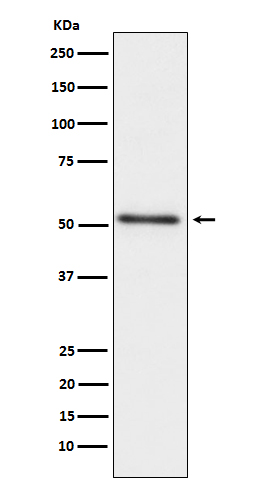
| WB | 1/1000-1/2000 | Human,Mouse,Rat |
| IF | 1/20-1/50 | Human,Mouse,Rat |
| IHC | IHC:1/100-1/200;IHF:1/50-1/200 | Human,Mouse,Rat |
| ICC | 1/50-1/200 | Human,Mouse,Rat |
| FCM | 咨询技术 | Human,Mouse,Rat |
| Elisa | 咨询技术 | Human,Mouse,Rat |
| Aliases | 5'-NT; 5'-nucleotidase; ACP3; PAP; Prostatic acid phosphatase; TMPase;;PAP |
| WB Predicted band size | Calculated MW: 45 kDa ; Observed MW: 50 kDa |
| Host/Isotype | Rabbit IgG |
| Antibody Type | Primary antibody |
| Storage | Store at 4°C short term. Aliquot and store at -20°C long term. Avoid freeze/thaw cycles. |
| Species Reactivity | Human |
| Immunogen | A synthesized peptide derived from human PAP |
| Formulation | Purified antibody in PBS with 0.05% sodium azide,0.05% BSA and 50% glycerol. |
+ +
以下是与前列腺酸性磷酸酶(Prostatic Acid Phosphatase, PAP)抗体相关的3篇代表性文献摘要概览:
---
1. **文献名称**:*Prostatic acid phosphatase as a serum marker for prostate cancer*
**作者**:Yam LT, et al.
**摘要**:该研究探讨了PAP作为前列腺癌血清标志物的潜力,通过免疫检测技术验证了PAP抗体的特异性,表明其在早期诊断和疾病监测中的应用价值。
---
2. **文献名称**:*Immune targeting of prostatic acid phosphatase enhances antitumor responses in prostate cancer models*
**作者**:Fong L, et al.
**摘要**:研究利用PAP抗体开发靶向免疫疗法,通过动物模型证明抗PAP抗体联合DNA疫苗可增强T细胞反应,抑制肿瘤生长,为前列腺癌免疫治疗提供新策略。
---
3. **文献名称**:*Monoclonal antibodies to human prostatic acid phosphatase: characterization and clinical utility*
**作者**:Loor R, et al.
**摘要**:报道了多种抗PAP单克隆抗体的开发与特性分析,验证了其在免疫组化与血清学检测中的高灵敏度和特异性,支持其在病理诊断中的应用潜力。
---
如需更具体的研究内容或近年文献,可进一步补充关键词或时间范围。
Prostatic Acid Phosphatase (PAP) is an enzyme primarily secreted by prostate epithelial cells, historically recognized for its role in hydrolyzing phosphate esters in seminal fluid. Though largely replaced by prostate-specific antigen (PSA) as a diagnostic marker, PAP remains relevant in specific clinical and research contexts. Elevated PAP levels in serum were once a key indicator of metastatic prostate cancer, but its current utility lies in immunohistochemistry (IHC) to distinguish prostate cancer from other malignancies and to monitor disease recurrence.
PAP antibodies are critical tools for detecting PAP expression in tissues or biological samples via techniques like IHC, ELISA, and Western blotting. These antibodies aid in studying PAP's biological functions, including its debated roles in tumor progression, bone metastasis, and immune modulation. Recent studies highlight PAP's potential as a therapeutic target, particularly in immunotherapies like sipuleucel-T, an FDA-approved vaccine for advanced prostate cancer that utilizes PAP-derived antigens to stimulate anti-tumor immune responses.
Structurally, PAP belongs to the hydrolase family, encoded by the ACPP gene on human chromosome 3. It exists as a homodimer, with enzymatic activity dependent on pH and substrate specificity. While its physiological role beyond the prostate remains unclear, PAP is also detected in non-prostatic tissues, including macrophages and neurons, suggesting broader regulatory functions. Research continues to explore its involvement in neuroendocrine cancers and interactions with cellular signaling pathways, reinforcing its dual significance as a diagnostic relic and emerging therapeutic avenue.
×